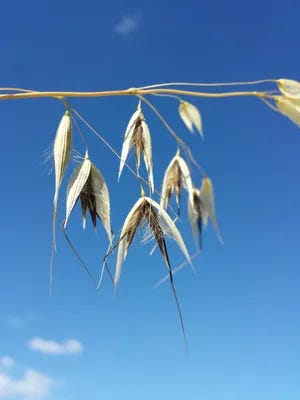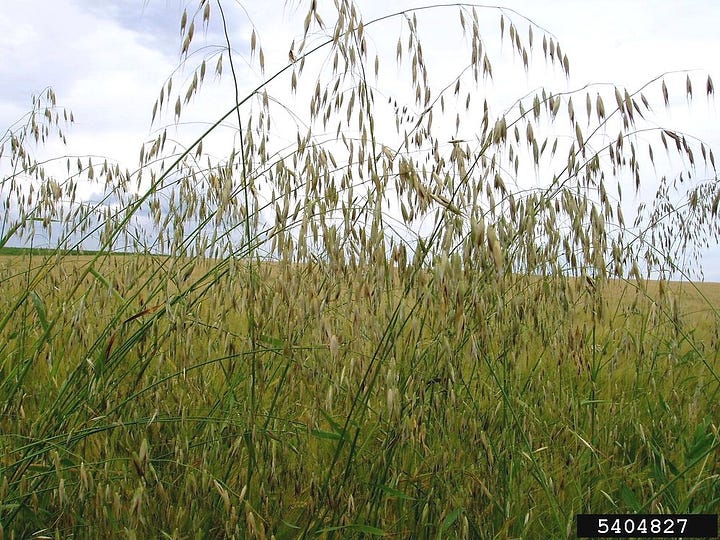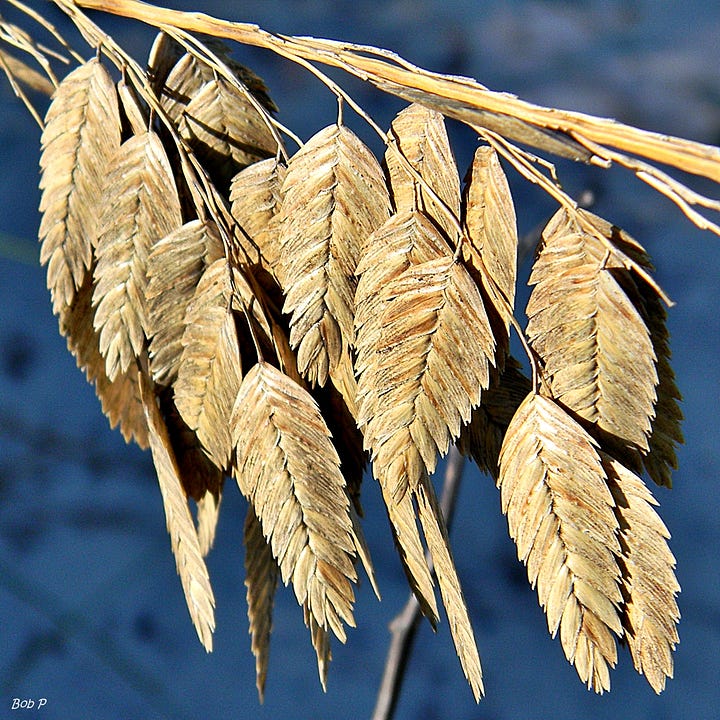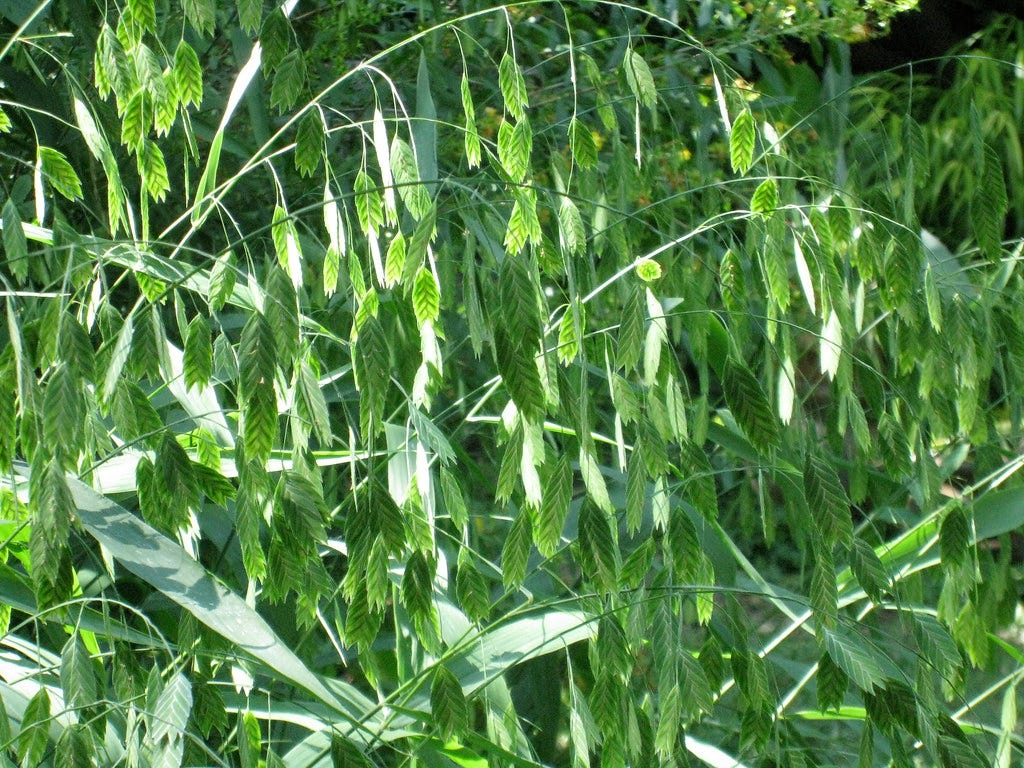ALSO KNOWN AS: Chasmanthium latifolium, fish-on-a-fishing-pole, northern wood-oats, inland sea oats, northern sea oats, wood oat
How to know
leaning panicles as thin as golden string
thick leaves, the width of tablespoons that rise up from the base
seed pods so flat like origami, they look like the underbellies of insects, the look like tight braids, they look perfect.
when a seed is in them they swell, just slightly
tap roots that go deeper than your arm.
Land blushes at the presence of water. In the same way witch hazel indicates a deep water source at its root, a landscape will transform where a river passes through it. This is particularly visible in the prairies and steppe where there is nothing to see for miles but sagebrush or grasses. This great expanse is slivered with lines of green: wildflowers and trees that trace rivers and streams. Just by existing, they bring with them an entire ecosystem that trails like a long elaborate veil at the river’s edge. They are long forests sheltering migrating species, as well as local dependents in otherwise harsh climates. These thin river landscapes are called ‘riparian’.
Garments of the River
I think we’ve forgotten that we are riparian too. Our cities have lined the shores of rivers for millennia. We followed rivers because they were highways. Water plants are endlessly useful and nutritious. But we’ve forgotten them as we cross bridges, fly over them in planes, or tunnel by them in trains. The river oats, however, will never forget their source. These grasses bend deep in the direction of the water in pristine arcs with fine dangling seed pods that look like cascading plaits and change color throughout the year. The grass follows as land slopes the the water’s edge. The river oat is always looking at the water.
River Oats or ‘inland’ sea oats, as their name suggests, are not sea oats at all, even though the two plants resemble one another. Of course the great expanse of the United states, turtle island, echoes the ancient ocean that was once here. Sea oats are giants compared to the river oats who grow in sandy and acidic. They can only handle a spare touch of salt. As it is with hearty grasses, they can also find home in clay soil. And for all their river enthusiasm, they are relatively drought tolerant. As part of the Chasmanthium, or wood oat genus, they are native to the Americas. The name Chasmanthium means “wide open flower” and latifolium means “fat leaf” in Latin. Rather than wide, I might deem the flower as flat, producing small bumps only as they seed.
They need a cold season in order to germinate, so they’re found places where coldness settles for a few months and are native to the eastern prairies, around Lake Michigan from Manitoba and south into northeastern Mexico, though some have traveled west to Colorado and Arizona - on rivers.
River oats are named for their riparian homes. Here they perform a valuable function of holding the soil together and filtering the water.
Even when they are not growing along rivers, they look for water wherever they are. They won’t grow in drought or beating sun. They’ll always look for water.
Their seed pods are their most beautiful feature, though they are subtle. They look like woven ripples in a current, or maybe they look like the undersides of beetles or shards of stained glass. The sun shines through them with a glorious glow. In spring they are green, in summer, golden, and by the autumn a sunset’s purple colors their fibers.
Seducing the Wind
The river oats usually grow in shade where they grow in a tall and lanky almost five foot back bend. In the rare occasion where they tolerate sun they reach a trim height of maybe two or three feet and produce a gingerly bow. They grow in clumps with roots that extend in the ground almost their height in the air and a lateral lacework of rhizome connecting one clump of grasses to the next. The roots are what make the grasses of the prairie so valuable. It’s what kept them alive through seasons of grazing. These roots provide a foundation in landscapes without massive tree roots. They are embroiderers of soil. Its thick underbrush hides, I imagine, whoever dissolves within it. Small rodents like mice, voles, and land bound birds like quail and turkey forage the seeds in autumn. For grazers and browsers, the leaves are more lush than most grasses. Their shoots look thick as Bermuda grass, but as they grow longer and they spread, nearly an inch wide with a soft green.
This entire plant is not one that stands tall. It grows about 4 feet then stops in a parabola. It doesn’t compete for sun because it doesn’t need much of it. Few plants dance like grasses do. This river oat bends and dances in pliant arcs because it has adapted to be a collaborator with wind. They don’t need to woo the bee or the butterfly or wasp with flashy colors or intoxicating smells. They don’t play that game.
They serve another, elemental being. Like all grasses, river oats are called anemophily: wind lovers.
The wind is not a picky pollinator like the insects. They take the pollen in gusts that act like massive palms and push the pollen away. As a plant, all you need to do is weave yourself with wind, the way we run our hands through water, they must be light and flexible. Their pollen grains are tiny and light as dust. The wind has been known to carry seeds and pollen over oceans. But this is rare. The wind will take up countless grains of pollen and settle them not far from their homes but far enough to mingle with other plants that have adapted to different circumstances. So if they don’t have access to wind, or if there are blocks or disruptions in the landscape the in wind is less likely to transfer genes. In addition to geographic blocks, pollen viability in grasses is surprisingly low. Thus their isolation becomes more and more extreme, physically and genetically. The decline of this grass is also a result of many species. They take longer to establish, and when the fifteen dams along the Colorado River alone, destroying the river’s natural floodplains which spread seeds, nutrients, and water. Before native grasses can reestablish themselves, plants such as phragmites will quickly move in.
Even though wind pollination is a chaotic business, as opposed to the precision and mastery an insect pollinated plant has perfected, some scientists speculate that more plants will eventually adapt to more wind pollinated forms or reproduction as insect pollinators become more rare due to climate change. The implications of this are, of course, massive. There is astonishingly little science knows about plants - and the wind pollinated ones in particular. They’re on this other plane, wiry and whispering.
Loose on the grassy plains and eastern bordering forests is a little brown butterfly that flies through the reckless cars on the massive interstates. None of the drivers could perceive its detail. If you look very closely, if you have the right angle. If you’re quiet enough you will see the profile of a mammalian animal with small determined eyes like a weasel or a raccoon - with white centers. Whatever creatrix makes butterflies knows how to draw mammals. If these butterflies can make it through the fragmented prairie to find the most graceful grass in the world - the river oats - they will lay their eggs, so the larval caterpillar will eat and carry on their generations. They are larval homes for skipper butterflies too - that look like fallen light.
People use the river oats like mood ring native grass ornamentals, but they have been used by the Cocopah nation as a food. Their seeds can be ground into flour. Not only do rivers wear the land well, they work it. The river oats’ roots create a fabric for the hardest working river in the United States - and I don’t mean the Mississippi. The Colorado River was powerful enough to carve the Grand Canyon, now much diminished by agriculture, land use and dams. The Cocopah are a people of the greater Yuman speaking peoples and known among themselves as the River People or Xawiƚƚ kwñchawaay, translating to “Those Who Live on the Cloudy River” as their ancestral land is along the epic Colorado River. They are the last keepers of the river before it flows into Mexico. And imagine the assistance grasses give in keeping the rivers, taking in the water and holding the soil, feeding and sheltering the animals under their leaning bodies.
myth for river oats
Music: La Cumparsita Gerardo Matos Rodríguez Arranged for Strings
Not to be confused with wild oats. These grasses are from the Eurasian continent and their seed pods don’t look so neatly braided as the river oats. They even have little frills like hair coming out of their open seeds pods.


Or sea oats. They have a similar seed, but the two are, in fact, related only in the sense that they are grasses. For a long time they were believed to be in the same genus. Thus these were named inland sea oats, to distinguish them.


Forager Friendly?
Make sure you look up their status as endangered species in your area. If they are not endangered or threatened harvest responsibly, leaving well over half of what you see.
Sources:
https://www.inaturalist.org/taxa/84364-Chasmanthium-latifolium
https://www.wildflower.org/plants/result.php?id_plant=chla5
https://plants.ces.ncsu.edu/plants/chasmanthium-latifolium/
https://plants.usda.gov/DocumentLibrary/factsheet/pdf/fs_chla5.pdf
https://www.sciencedirect.com/topics/agricultural-and-biological-sciences/wind-pollination
https://storymaps.arcgis.com/stories/2efeafc8613440dba5b56cb83cd790ba
https://esa.org/seeds/toolkits/pollinator/science-summary/
https://hamiltonnativeoutpost.com/product/river-oats/
https://www.eattheweeds.com/tag/cocopah-indians/
https://pmc.ncbi.nlm.nih.gov/articles/PMC2701749/
https://en.wikipedia.org/wiki/Cocopah





